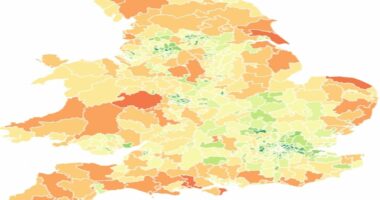Share this @internewscast.com
It’s the northernmost state in America, made up of remote towns and villages that suffer from brutal weather and months of darkness.
Aside from Alaska’s harsh climate, the state also has to contend with a rising number of birth defects.
A 2021 report from the Alaska Native Tribal Health Consortium reported that in 2017 – the latest data available – there were 651 birth defects per 1,000 live births among native children, an increase from 174 per 1,000 births a decade earlier.
In non-native kids, the rate was 266 per 1,000 births, a decline from 312 in 2007.
The US average is about 33 defects per 1,000 births. Overall rates have been stable, though certain types of abnormalities are on the rise nationwide, including congenital heart defects.
The most common birth defects among Alaskan babies, according to the 2021 report, were cardiovascular (33 percent) and musculoskeletal (24 percent).
One musculoskeletal defect that has emerged in Alaska is clubfoot, an abnormality that causes a baby’s feet to turn inward.
According to the National Birth Defects Prevention Network (NBDPN), between 2016 and 2020, the rate of clubfoot was reported to be between 2.8 and 3.1 babies per 1,000 live births.

Alaska is the northernmost state in the US, and along with being battered by brutal weather conditions and plunged into almost two months of darkness, it is seeing a rising number of birth defects

This is the highest rate in the US, where the average is about one in 1,000 births.
According to March of Dimes, clubfoot prevalence was highest among Alaskans of Asian and Pacific Islander descent, at an average of 4.6 incidences per 1,000 live births between 2014 and 2017.
American Indian and Alaskan Native rates were 3.6 per 1,000 births.
Clubfoot, also called talipes equinovarus, occurs when a baby’s foot turns inward so much that the bottom of the foot faces sideways or up.
It happens because the tendons that connect the muscles to bones in the baby’s leg and foot are shorter than they should be.
About half of babies who have clubfoot have it in both feet.
Although clubfoot is not painful for an infant, treatment is necessary to allow for normal walking and development.
If left untreated, a baby will have trouble walking, be susceptible to infections on their feet, have thickened skin on the foot and develop arthritis.
Treatment includes physical therapy and in some cases surgery.
But access to rehabilitation in remote communities like those in Alaska can be significantly limited.
Rural Health Information Hub estimates one-third of the state’s population – about 240,000 people – live in rural areas.
While the exact reasons for this increased prevalence of the particular condition are not fully understood, experts believe that there are several factors at play.
The prevalence of birth defects among native children is about 2.5 times higher than among white children.

Living near hazardous waste sites or having exposure to other environmental toxins can increase the risk of birth defects (remote Alaskan village of Utqiagvik pictured above)

A musculoskeletal defect that has emerged in Alaska is clubfoot
Other common birth defects in the state include heart defects, cleft lip and palate, and spina bifida.
Some research suggests certain gene variations may be more common in Alaskan Native populations, potentially increasing the risk for specific birth defects.
These variations don’t guarantee the development of a condition, but they do increase susceptibility.
Previous studies have also shown maternal smoking can increase birth defect risks, and surveys have revealed a high percentage of women of child-bearing age smoke in Alaska.
Living near hazardous waste sites or having exposure to other environmental toxins can also increase risk levels.
Disposing of hazardous waste in rural areas is often difficult due to remoteness, harsh weather and inadequate infrastructure. As a result, it is sometimes disposed of in ways that allow dangerous chemicals to seep out and into surrounding soil, negatively impacting ecosystems and human health.

Additionally, air pollution and contamination of ground water from manufacturing plants or local businesses can also expose pregnant residents to toxins.
In addition to genetics and toxic waste, alcoholism can play a role the problem that has seemingly plagued these remote parts of the country.
The high number of alcohol-related birth defects in remote and rural Alaskan communities have led to the implementation of various measures, including alcohol bans.
The most common alcohol-related birth defects involve the nervous system, heart and skeletal system.
These can include conditions like microcephaly – a small head – heart defects and skeletal abnormalities such as radioulnar synostosis, the abnormal connection of the forearm bones.
Facial abnormalities like cleft lip and palate, and sensory issues such as vision and hearing problems are also frequently observed.














